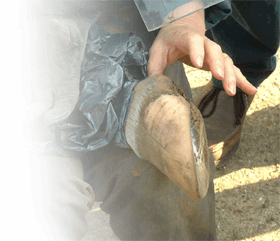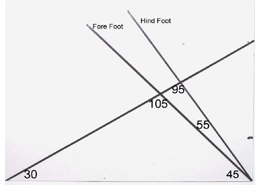IN DEFENCE OF DR STRASSER
The comments here apply mainly to her advice on the trimming of horses‘ feet. I accept many of her opinions on horse management and lifestyle, but for very many of my clients they are impractical to a greater or lesser degree.
| "Both the ILPH and the Laminitis Trust are very concerned about the method of trimming horses feet espoused by a German veterinary surgeon Dr H. Strasser. Although no doubt well meaning, our experiences with laminitis and foundered horses and ponies in the UK that have been subjected to the "Strasser trim", as it has become known, have been entirely unfavourable." |
| "We would strongly urge anyone considering using this method of treatment for laminitis and founder cases, NOT TO DO SO." |
| Quote from the Laminitis Trust Website |
"The Strasser Trim"

In Defence
When I attended her course I believed that the advice and demonstrations that she gave about trimming horses‘ feet were safe.
Reservations
Many of the problems attributed to her methods are to do with the knowledge and abilities of the lay trimmers using her methods. The "prescription" trim in the wrong hands may not take into account distortions and variations in individual horses.
The Plastic Sheet (Plexiglas)

In Defence
The use of the plastic sheet used by Strasser Trimmers is an extremely valuable tool and that the angles are consistent with the vast majority of horses, whether they have laminitis or not. (see Strasser's plastic sheet)
Reservations
The angles are not constant in a small number of animals e.g. in foals and true club feet, and it is important to be able to identify these.

The Bars
In Defence
She has highlighted the significance of the bars in the horses‘ feet and advises the trimming of them. (see my notes on "The Bars" also the quotes of others)
Reservations
If done within reason.
Ground-Parallel Pedal Bone
In Defence
She advocates trimming all horses‘ feet with a ground-parallel pedal bone. I believe that this is correct in laminitis.
Reservations

I picture the most stable position of the pedal bone, in relation to the hoof, to be with a ground-parallel pedal bone so that the forces on the laminae are evenly spread around the whole foot. If the foot is trimmed with a ground-parallel pedal bone, as the horse exercises at faster speeds and the hoof expands, the foot will spread causing tilting back of the pedal bone and putting unnatural stresses on parts of the foot. Consideration should be given to what exercise the horse will be doing and whether it is shod so that at maximum speed the pedal bone will not tilt back beyond the level.
Hoof Mechanism
In Defence
She advises exercise rather than restriction, to improve function in the foot and to improve circulation. I believe that this has huge significance in the prevention of insulin resistance and laminitis.
Reservations
If there is instability in the foot in laminitis then walking the horse is likely to cause further separation and damage in the feet. This will be worse in horses trimmed with higher angles (more upright feet). Walking should only be done if there is sufficient stability of the pedal bone in the hoof, as indicated by the level of pain or lack of it.
Dr Strasser says that blood is drawn into the foot when the hoof expands as weight is applied. Logic (and Dr Pollitt) tells me that it must empty of blood when weight is taken. It is the pumping action that is the important factor for "hoof mechanism".
Frequent Hoof Trimming
In Defence
Because the horses are not shod then it is easy to trim the feet very regularly which will help to correct distortions in the non laminitic foot and to help to prevent distortions in the laminitic foot.
Reservations
None
Keeping All Horses Unshod

In Defence
Some horses cope perfectly well unshod. Consideration should be given as to whether a horse need to be shod or not, and will depend on the individual, the environment and the type of work it will be required to do.
Reservations
This should be thought about rather than just shoeing horses because that is the "done thing". Horses should be shod if they need to be.
In conclusion:
It is my opinion that Dr Strasser and the "Strasser Trim" should not be rejected out of hand. I believe that some of her ideas are of great significance particularly in dealing with the laminitic horse or pony.
1: The foot trimmed with a ground-parallel pedal bone - I agree with this only in the laminitic. Others disagree with this (see How should we trim the chronic founder ?.)
2: The use of her plastic sheet to identify the position of the pedal bone in the hoof without the use of x-rays.
3. Pointing out the advantages of the "hoof mechanism", even if, in my opinion, she has the input and output of blood in the hoof to be the wrong way round.
4. Frequent trimming of the feet, particularly in chronic founder cases.
5. The trimming of the bars. - I agree with this but others disagree (see The Bars & Articles on bars)
It is perhaps the practice rather than the theories that we should be cautious of.
I believe that the "Strasser Trim" is not so suitable in the non-laminitic horse and is often too severe.
Horse owners who decide to follow Dr Strasser‘s theories and trim are told that their horse may be lame for up to a year until the "new" horn can grow from the top to the ground. This is obviously not going to be a great selling point for a vet or a farrier to advise owners to do but, in defence, many of the people who decide to follow Dr Strasser‘s theories have horses that are lame and have been told by their vet or farrier that the horse will not get better and should be put down.
Many of the people who are critical of Dr Strasser have never attended one of her courses or read her books. My criticism after I attended her course was that she was selective of the science she uses, but when it comes to matters of the horse‘s foot then I believe we are all guilty of that. I certainly am.
see Dr H.Strassers thoughts upon my comments